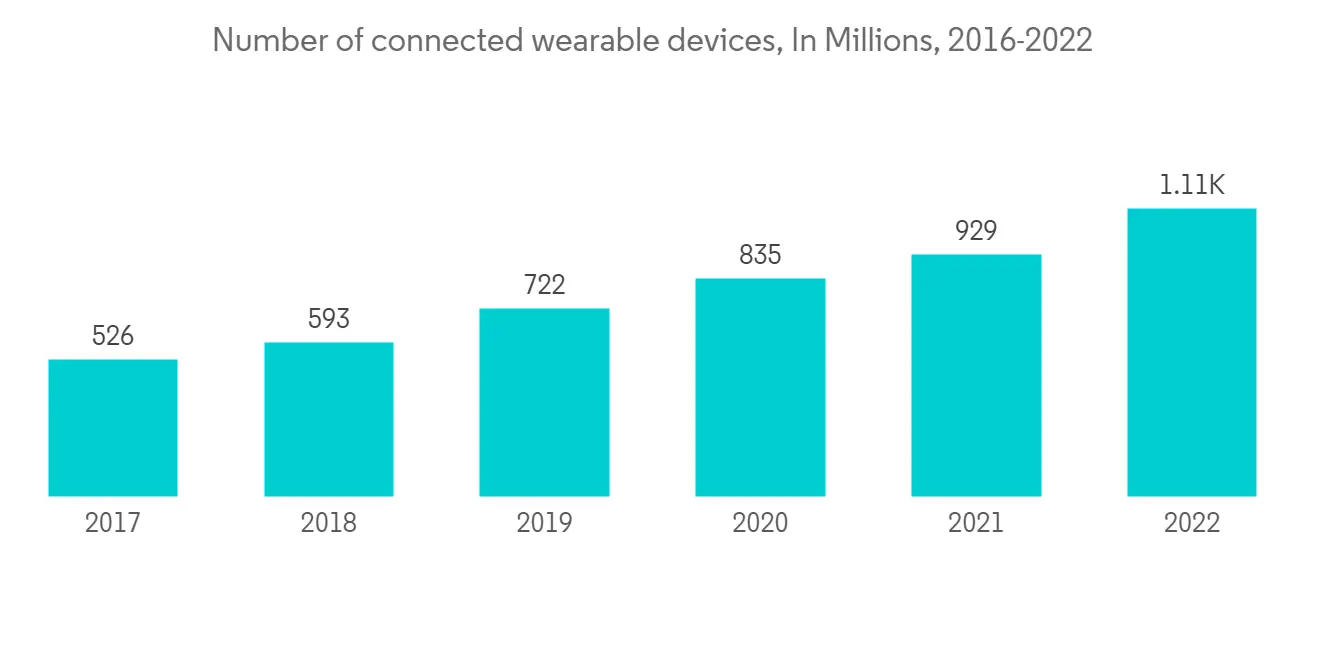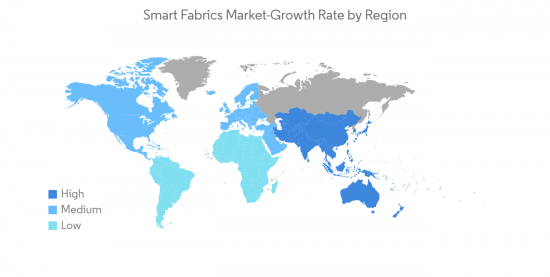 |
市場調査レポート
商品コード
1329885
スマートファブリック市場規模・シェア分析- 成長動向と予測(2023年~2028年)Smart Fabrics Market Size & Share Analysis - Growth Trends & Forecasts (2023 - 2028) |
||||||
● お客様のご希望に応じて、既存データの加工や未掲載情報(例:国別セグメント)の追加などの対応が可能です。 詳細はお問い合わせください。
| スマートファブリック市場規模・シェア分析- 成長動向と予測(2023年~2028年) |
|
出版日: 2023年08月08日
発行: Mordor Intelligence
ページ情報: 英文 100 Pages
納期: 2~3営業日
|
- 全表示
- 概要
- 目次
スマートファブリック市場規模は、2023年の614万ユニットから2028年には1,027万ユニットに拡大し、予測期間(2023-2028年)のCAGRは10.85%となる見込みです。
スマートテキスタイルは、ユーザーに機能性を向上させる技術を統合するために製造・設計された織物です。健康モニタリング、保護と安全、健康的なライフスタイルなど、ウェアラブル・テキスタイルをベースとしたパーソナル・システムに向けた研究開発は、ここ数年大きな関心を集めています。最近、マサチューセッツ工科大学(MIT)は、人間の健康の最も重要な指標、すなわち心拍数、呼吸数、体温を追跡するスマート衣類を開発しました。これは、肌にフィットする高感度センサーを生地に縫い付けることで実現しました。
主なハイライト
- ウェアラブル・エレクトロニクス産業の成長が市場を牽引しています。さまざまなエンドユーザー産業でスマートウェアラブルの需要が高まっていることが、スマートファブリック市場の成長を促す主な要因となっています。布製ウェアラブルの決済機能を拡張するための取り組みが盛んです。マスターカードはタイメックスと提携し、非接触型決済を腕時計に組み込みました。このような傑出したアプリケーションが主流となり、それが実現すれば、市場はスマートファブリックの同様の動向に対応するように変化する可能性が高いです。
- エレクトロニクスの小型化とフレキシブル・エレクトロニクスの開拓が市場を牽引しています。センサー、アクチュエーター(アクティブ・スマートテキスタイル用)、制御ユニット(アドバンスド・スマートテキスタイル)といった小型化された電子機器の進歩により、スマートファブリックの効率は向上しています。多機能プラスチック製造、ナノスケール製造、プリンテッドエレクトロニクスの分野で重要な専門知識が見られます。例えば、UMass Lowellはフレキシブル・エレクトロニクスとスマートテキスタイルを開発しており、現在進行中の研究プロジェクトもあります。高周波プリントコンフォーマルアンテナ、カーボンベーストランジスタ、フォトニックデバイスを開発し、軍用ウェアラブルアンテナを調査しています。
- さらに、繊維、糸、織物の形状をしたウェアラブルなトライボエレクトリック・ナノジェネレーターの開拓は、研究対象市場の著しい発展を可能にしています。これらのナノジェネレータは、スーパーキャパシタ、リチウム電池、太陽電池などのデバイスと効果的に統合されると、自己充電ウェアラブルシステムを実現するための実現可能性が証明され、スマートウェアラブルの注目を集めるようになっています。
- 例えば、繊維製造会社のネクスタイルズは最近、生理学的・生体力学的データを記録するスマート糸技術でスポーツ・パフォーマンス業界に参入しました。日常的なスポーツウェアに使用される柔軟な布は、従来の縫製方法とプリント回路基板を融合させることでネクスタイルズが生み出しました。ネクスチャイルズの生地は、特許取得済みの製造技術により、バイオメカニクスとバイオメトリック・センシングを1つのプラットフォームに記録することができます。
- さらに、COVID-19の発生により、市場は大幅な成長を遂げることはありません。スマートファブリックの製造には高度な自動化が必要であり、電子制御システム、コンピューター支援設計、自動検査などの繊維加工技術の進歩が必要だったからです。この産業は、「アパレル・生活雑貨」のカテゴリーに分類されるため、必要不可欠なサービス・セグメントには含まれず、その結果、工場は現在稼働していないです。
スマートファブリックス市場動向
ファッションとエンターテインメント産業が著しい成長を遂げる
ファッションとエンターテインメント産業は、スマートファブリックを使用して衣服に独自の美学を取り入れます。衣服の色、サイズ、形といった外観の特徴は、生地に織り込まれた技術を使って変えることができます。衣服のスマートファブリックは、ユーザーが周囲と相互作用したり、ウェアラブル・デバイスで着用する衣服を通して、埋め込まれたセンサーや導電糸を介してデータを通信したりすることを可能にします。
ファッション業界では、情報を中継することができる便利な技術的アーキテクチャと統合された、新しく審美的に楽しい衣装を考え出すデザイナーのイノベーションが、調査された市場を牽引しています。ユニクロやルルレモンを含む多くのブランドが、スマート素材を使用してコレクションを先行しています。
アンダーアーマー、リーバイス、トミー・ヒルフィガーなど多くの著名ブランドや、センソラ、ルーミア、ヘキソスキン、キュートサーキットなどの中小企業が、スマートファブリックを使用したスマートウェアを提供し、他社に先駆けてコレクションを展開しています。例えば、CuteCircuitはオートクチュール・コレクションや特別プロジェクトにスマート素材を使用しています。CuteCircuitの「Hug Shirt」は、衣服内のセンサーを通してユーザーに電子ハグを送ることができます。
フランスの新興企業Spinali Designは、日焼け止めを塗る時期を知らせる紫外線センサーや、子供が波打ち際に近づきすぎたときに親に知らせる距離トラッカーを内蔵した高級ビーチウェアを製造しています。
さらに、過去数年間、グーグルはリーバイ・ストラウス社とプロジェクト・ジャカードの下、将来のスマート・ジーンズ・ジャケットの開発に取り組んできました。

北米が大きな市場シェアを占める
北米はスマートファブリックス市場で大きなシェアを占めると予想されており、米国が主要シェアを占めています。コネクテッド・ウェアラブル製品は大きな動向となっており、フィットネスバンド、スマートウォッチ、スマートグラスなど、さまざまな形態で普及しています。
このようなウェアラブル電子機器の採用増加は、人間の快適さ、健康、幸福を大幅に向上させるため、スマートファブリック市場に新たな道を開くと予想されています。
さらに、カナダ軍はIAVストライカー・ユニットにフルファブリック・キーボードを採用しています。これは、より軽く、持ち運びが快適で、壊れやすい部品が少ないように設計されています。
さらに、この地域では、スマートファブリック開発の研究レベルが一歩進んでいます。この地域では、各個人の周囲の微気候をコントロールするのに役立つ適応型防寒着を作るための研究開発が行われています。例えば、OtherLabのスピンアウト企業であるKestrel Materialsは、熱膨張係数を戦略的にミスマッチさせた繊維バイモルフ構造に基づく熱適応衣服技術を商品化しています。
2022年7月、マサチューセッツ工科大学(MIT)の研究者たちは、革新的な製造プロセスを用いて、着用者の位置や行動を感知する身体に適応するスマートファブリックを開発しました。研究チームは、特定の種類のプラスチック糸を一体化し、熱成形を施すことで、3DKnITSとして知られる多層ニットテキスタイルに織り込まれた圧力センサーの精度を大幅に向上させることに成功しました。この方法は「スマート」な靴とマットの開発に利用され、圧力センサーからのデータをリアルタイムで収集・分析するハードウェアとソフトウェアシステムが開発されました。機械学習アルゴリズムは、人がスマートテキスタイル・マットの上に立っているときの動きやヨガのポジションを予測し、その精度はおよそ95%だっています。

スマート繊維産業の概要
スマートファブリックス市場は断片化されているが、これは複数のベンダーが最近資金を調達し、生産に回しているためです。例えば、ゼノマはAOKIと豊島から追加出資を受けて資金を調達しました。このようなケースは、市場のライバル関係を助長しています。さらに、インテグレーター・レベルの利害関係者を考慮すると、前方統合が見られます。ヘキソスキンやセンソリアのような企業は、最終消費者の製造可能性に関する競合を高めています。最近の市場開拓は以下の通り。
2022年7月、カリフォルニア州カルバーシティを拠点とするLoomia Technologies社は、Advanced Functional Fabrics of America社(AFFOA社)と提携し、商業・レジャー用および軍事用の顧客向けに、触感の高い加熱式ハンドウェアを製造します。AFFOAは、消費者の発見をリードし、建築的なシステム設計を提供し、インターフェース制御ユニットを作成する一方、Loomiaは、その革新的なeテキスタイル技術を提供し、加熱ハンドウェアの実現に貢献します。
その他の特典:
- エクセル形式の市場予測(ME)シート
- 3ヶ月間のアナリスト・サポート
目次
第1章 イントロダクション
- 調査の前提条件と市場定義
- 調査範囲
第2章 調査手法
第3章 エグゼクティブサマリー
第4章 市場力学
- 市場概要
- 業界の魅力度-ポーターのファイブフォース分析
- 供給企業の交渉力
- 消費者の交渉力
- 新規参入業者の脅威
- 競争企業間の敵対関係
- 代替品の脅威
- 業界バリューチェーン分析
- COVID-19の業界への影響評価
第5章 市場力学
- 市場促進要因
- ウェアラブル・エレクトロニクス産業の成長
- エレクトロニクスの小型化とフレキシブルエレクトロニクスの発展
- 市場の課題
- 高コストとデータセキュリティへの懸念
第6章 市場セグメンテーション
- タイプ
- パッシブスマートファブリック
- アクティブ・ファブリック
- ウルトラスマートファブリック
- 用途
- ファッションとエンターテイメント
- スポーツとフィットネス
- 医療
- 輸送・その他
- 宇宙・軍事
- 産業
- 地域
- 北米
- アジア太平洋
- 欧州
- 世界のその他の地域
第7章 競合情勢
- 企業プロファイル
- AIQ Smart Clothing Inc.
- Adidas AG
- NIKE Inc.
- ThermoSoft International Corporation
- Kolon Industries Inc.
- Interactive Wear AG
- Ohmatex
- Schoeller Textil AG
- Sensoria Inc.
- OTEX Specialty Narrow Fabrics Inc.
第8章 投資分析
第9章 市場機会と今後の動向
The Smart Fabrics Market size is expected to grow from 6.14 million units in 2023 to 10.27 million Units by 2028, at a CAGR of 10.85% during the forecast period (2023-2028).
Smart textiles are fabrics that are manufactured and designed to integrate technologies that offer the user increased functionality. R&D toward wearable textile-based personal systems, such as health monitoring, protection and safety, and healthy lifestyles, gained major interest over the last few years. Recently, MIT developed smart clothing that follows the most important indicators of human health, i.e., heart rate, respiratory rate, and temperature. This was achieved by sewing into the fabric of sensitive sensors that fit the skin.
Key Highlights
- The growth in the wearable electronics industry is driving the market. The growing demand for smart wearables across various end-user industries is the major factor driving the growth of the smart fabric market. A significant amount of effort is witnessed to expand what fabric wearables can do with respect to payments. Mastercard partnered with Timex to integrate contactless payments into their watches, while a U.K.-based CashCuff did the same with the cufflinks. When such distinguished applications become mainstream, which it has, the market is very likely to shift to accommodate similar trends in smart fabrics.
- Miniaturization of electronics and developments across flexible electronics is driving the market. The efficiency of smart fabrics is enhancing with the advancement in miniaturized electronic items, such as sensors, actuators (for active smart textiles), and controlling units (advanced smart textiles). Significant expertise in multifunctional plastics manufacturing, nanoscale manufacturing, and printed electronics has been seen. For instance, UMass Lowell develops flexible electronics and smart textiles-some ongoing research projects. We are developing high-frequency printed conformal antennas, carbon-based transistors, and photonic devices and researching wearable antennas for the military.
- Further, the developments on wearable triboelectric nanogenerators in shapes of fiber, yarn, and textile enable a signficant development in the market studied. These nanogenerators, when effectively integrated with devices such as supercapacitor, lithium battery, and solar cell, their feasibility for realizing self-charging wearable systems have been proven to attract the attention of smart wearables.
- For instance, Nextiles, a textile manufacturing firm, recently entered the sports and performance industry with smart thread technology that records physiological and biomechanical data. The flexible cloth used in everyday sportswear was created by Nextiles by fusing conventional stitching methods with printed circuit boards. Nextiles' fabrics enable biomechanic and biometric sensing recorded on one platform owing to the patented production technique.
- Further, with the outbreak of COVID-19, the market did not experience substantial growth. This is because manufacturing smart fabric needed a high degree of automation and advancements in textile processing techniques such as electronic controlling system, computer-aided design, automated inspection, etc. The industry did not come under the essential services segment as it was considered in the "apparel and lifestyle goods" category, resulting from which factories were currently not under operations.
Smart Fabrics Market Trends
Fashion and Entertainment Industry to Witness Significant Growth
The fashion and entertainment industry uses smart fabrics to incorporate unique aesthetics into clothing. Appearance features, such as color, size, or shape of garments, can be altered using technology woven into fabrics. Smart fabrics in clothes enable the user to interact with their surroundings and communicate data via embedded sensors or conductive yarn through the clothes they wear with wearable devices.
In the fashion industry, the market studied is driven by innovations of the designers coming up with new and aesthetically pleasing outfits integrated with a useful technical architecture capable of relaying information. Many brands, including Uniqlo to Lululemon, use smart fabrics to set their collections ahead of the pack.
Many prominent brands such as Under Armour, Levi's, and Tommy Hilfiger, among others, along with smaller companies such as Sensora, Loomia, Hexoskin, CuteCircuit, are offering their smart clothing that are using smart fabrics to set their collections ahead of the others. For instance, CuteCircuit utilizes smart fabrics for its haute couture collections and special projects. CuteCircuit's 'Hug Shirt' allows the user to send electronic hugs through sensors within the garment.
The French startup Spinali Design makes high-end beachwear with integrated ultraviolet light sensors that tell the wearer when it's time to apply sunscreen and distance trackers that tells the parents when the kids have wandered too close to the surf.
Further, for the past few years, Google worked with Levi Straus on a future smart jean jacket under Project Jacquard, which would eventually lead to a jean jacket with smart fabric sleeves and built-in touch controls.

North America to Account for a Significant Market Share
North America is anticipated to substantiate a prominent share in the smart fabrics market, with the United States region accounting for the major share. Connected wearable products are gaining significant trends and have been around in various forms, such as fitness bands, smartwatches, smart glasses, and among others.
This increasing adoption of wearable electronics devices is anticipated to open new avenues for the smart fabrics market as they offer significant enhancements to human comfort, health, and well-being.
Furthermore, the Canadian military has used full-fabric keyboards in its IAV Stryker units, developed to replace the bulky, traditional hardware. These are designed to be lighter, more comfortable to transport, and have fewer components to break.
Moreover, the level of research for developing smart fabrics has taken a step ahead in the region. The region has been witnessing research and developments to create adaptive thermal clothing that could help control the microclimate around each individual. For instance, Kestrel Materials, an OtherLab spin-out company, commercializes thermally adaptive garment technology based on textile bimorph structure with strategically mismatched coefficients of thermal expansion.
In July 2022, MIT researchers developed smart fabrics that adapt to the body to sense the wearer's position and actions using an innovative production process. The researchers were able to significantly increase the precision of pressure sensors woven into multilayered knit textiles known as 3DKnITS by integrating a particular kind of plastic yarn and applying thermoforming. This method was utilized to develop a "smart" shoe and mat, and a hardware and software system was then developed to collect and analyze data from the pressure sensors in real time. With an accuracy rate of roughly 95%, the machine-learning algorithm anticipated the movements and yoga positions that a person would make while standing on the smart textile mat.

Smart Fabrics Industry Overview
The Smart Fabrics Market is fragmented because multiple vendors have been witnessed raising funding recently to be channelized onto productions. For instance, Xenoma raised funds through additional investment by AOKI and TOYOSHIMA. These instances cater to market rivalry. Further, forward integration has been witnessed when considering the integrator-level stakeholders. With companies like Hexoskin and Sensoria, the competition has risen concerning end-consumer manufacturability. Recent developments in the market are -
In July 2022, Loomia Technologies, based in Culver City, California, collaborated with Advanced Functional Fabrics of America (AFFOA) to produce highly tactile, heated handwear for commercial/recreational and military customers. AFFOA will lead consumer discovery, provide architectural system designs, and create an interface control unit, while Loomia will contribute its innovative e-textile technology to making heated handwear a reality.
Additional Benefits:
- The market estimate (ME) sheet in Excel format
- 3 months of analyst support
TABLE OF CONTENTS
1 INTRODUCTION
- 1.1 Study Assumptions and Market Definition
- 1.2 Scope of the Study
2 RESEARCH METHODOLOGY
3 EXECUTIVE SUMMARY
4 MARKET DYNAMICS
- 4.1 Market Overview
- 4.2 Industry Attractiveness - Porter's Five Forces Analysis
- 4.2.1 Bargaining Power of Suppliers
- 4.2.2 Bargaining Power of Consumers
- 4.2.3 Threat of New Entrants
- 4.2.4 Intensity of Competitive Rivalry
- 4.2.5 Threat of Substitute Products
- 4.3 Industry Value Chain Analysis
- 4.4 Assessment of Impact of COVID-19 on the Industry
5 MARKET DYNAMICS
- 5.1 Market Drivers
- 5.1.1 Growth in Wearable Electronics Industry
- 5.1.2 Miniaturization of Electronics and Developments across Flexible Electronics
- 5.2 Market Challenges
- 5.2.1 High Cost and Data Security Concerns
6 MARKET SEGMENTATION
- 6.1 Type
- 6.1.1 Passive Smart Fabrics
- 6.1.2 Active Fabrics
- 6.1.3 Ultra-smart Fabrics
- 6.2 Application
- 6.2.1 Fashion and Entertainment
- 6.2.2 Sports and Fitness
- 6.2.3 Medical
- 6.2.4 Transportation and Others
- 6.2.5 Space and Military
- 6.2.6 Industrial
- 6.3 Geography
- 6.3.1 North America
- 6.3.2 Asia Pacific
- 6.3.3 Europe
- 6.3.4 Rest of the World
7 COMPETITIVE LANDSCAPE
- 7.1 Company Profiles
- 7.1.1 AIQ Smart Clothing Inc.
- 7.1.2 Adidas AG
- 7.1.3 NIKE Inc.
- 7.1.4 ThermoSoft International Corporation
- 7.1.5 Kolon Industries Inc.
- 7.1.6 Interactive Wear AG
- 7.1.7 Ohmatex
- 7.1.8 Schoeller Textil AG
- 7.1.9 Sensoria Inc.
- 7.1.10 OTEX Specialty Narrow Fabrics Inc.
